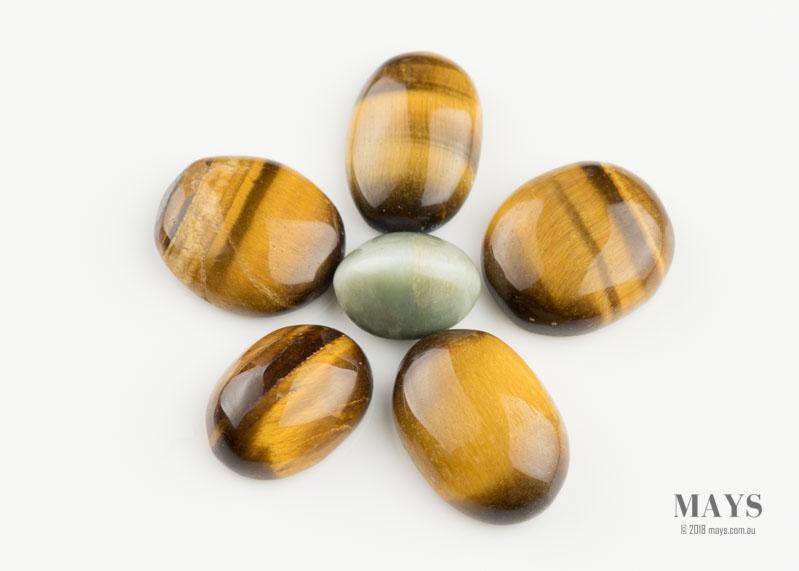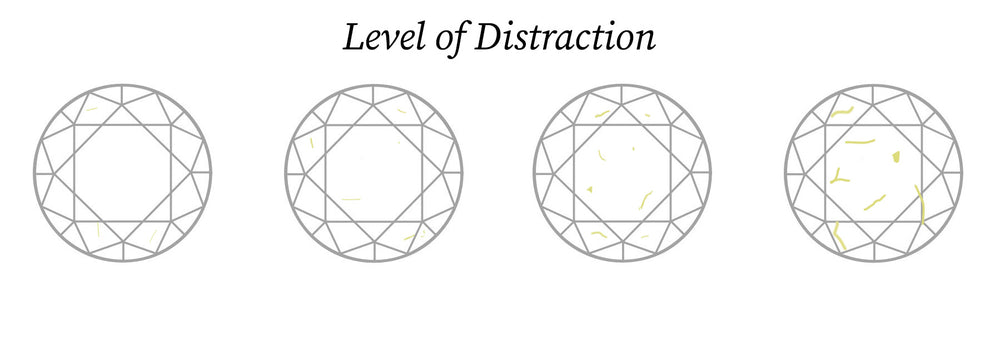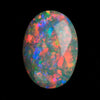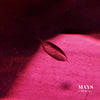7 Tips on Buying Gemstones in Australia
Table of Contents
Types of Gemstones for Sale in Australia
Australia produces world renown gemstones like the Australian Opal, Australian Sapphires and Australian Pink Diamonds but before we get into each specific gemstones, let’s get into what gemstone material types are available here in Australia. Knowing which type you want will help narrow down the search in finding them.
 A mix of gem quality roughs with some in crystal form. In the mix are: Aquamarine, Ruby, Spinel crystals, Sapphire, Peridot, Topaz.
A mix of gem quality roughs with some in crystal form. In the mix are: Aquamarine, Ruby, Spinel crystals, Sapphire, Peridot, Topaz.
Gemstone Roughs
A raw product of gemstones before they are cut and polished. Gemstone roughs can come in various qualities. Higher quality minerals can be cut and polished into faceted gemstones to obtain high lustre and clarity.
 A beautiful mineral slab ready to be cut into a cabochon.
A beautiful mineral slab ready to be cut into a cabochon.
Mineral Slabs
Large minerals or rocks that have sliced into manageable pieces to be cut into cabochons or carvings. They are typically a raw product for ornamental gemstones. With jade, slabs are drilled to create jade bangles and jade rings.
 A pair of faceted spinel gemstones from Mogok, Myanmar (Burma).
A pair of faceted spinel gemstones from Mogok, Myanmar (Burma).
Faceted gemstones
High quality gemstones that are ready to be set into jewellery. Faceted gemstones have a pavilion, crown, culet, girdle and table. The crown refers to the top half of the gemstone, above the girdle. It’s the part that is normally visible when mounted on jewellery.
 A pair of Quartz crystals: Amethyst and Citrine. Definite geometric faces seen in the form of rhombohedrals.
A pair of Quartz crystals: Amethyst and Citrine. Definite geometric faces seen in the form of rhombohedrals.
Crystals
Minerals that display definite external geometric faces and forms.
 An agate geode found in Australia.
An agate geode found in Australia.
Geodes
Large hollow volcanic rocks naturally filled with crystals growth and other minerals. They are cut in halves to be used as decorative display.
 Assorted cabochon gemstones. From the left: Star Sapphire, Parti Sapphire, Blue Sapphire, Jadeite, Star Diopside.
Assorted cabochon gemstones. From the left: Star Sapphire, Parti Sapphire, Blue Sapphire, Jadeite, Star Diopside.
Cabochons
Gemstones that have been cut with a domed top with a flat or hollow base are called Cabochons. Usually in oval shapes but can be round as well. This type of cutting is required for certain types of sheen to show like the star in a star sapphire or chatoyancy in a Tiger’s eye.
 A natural, wild caught South Sea Pearl from Southern Myanmar.
A natural, wild caught South Sea Pearl from Southern Myanmar.
Organic Gemstones
Gemstones that are created through organic processes. Amber, pearls, mother of pearl, coral, jet, ivory, tortoise shell and ammolite are all examples of organic gemstones.
 A cat eye ornamental gemstone surrounded by tiger eye gemstones.
A cat eye ornamental gemstone surrounded by tiger eye gemstones.
Ornamental Gemstones
Gemstones that are made out of rocks or minerals that typically lack transparency but have beautiful patterns. They're usually cut into cabochons. Examples are: Turquoise, tiger iron, rose quartz and lapis lazuli.
Gemstone Classification: Precious or Semi-Precious
Classifying a gemstone as precious or semi-precious is an old classification system for gemstones used in jewellery from the western world but it’s still widely used today in the trade. A loosely based marketing term without any scientific backing. Rarer, higher value gemstones were considered precious and the more common gemstones were classified as semi-precious. Diamond, emerald, ruby and sapphire were the original gemstones considered as precious and all the rest were semi-precious, but from time to time, opals, pearls, and jade have been added to the precious list depending on who was selling. It can be a misleading classification because it doesn’t consider the quality factors of a gemstone. For example, a low quality sapphire isn’t going to be higher in value than a high quality aquamarine which was often referred to as semi-precious.
Classification in Australia
In Australia, gemstone classification is no longer encouraged by the Gemmological Association of Australia and all faceted gemstones are considered equally precious. Dealers of crystals, minerals, healing gemstones, and ornamental gemstones do still refer to their products as semi-precious though.
Factors that affect the Price and Value of Colour Gemstones
The Colour in Coloured Gemstones
In the world of gemstones, colour is everything. Highly sought after colours, or colours that are rarely found in nature demands higher prices. In opal, the more red, the more the price. Blue sapphires should be evenly saturated with a medium blue tone, too dark or too light and the value goes down too. Expensive colours come with their own names. Pigeon blood in a Burmese ruby is the most expensive. Royal blue in a blue sapphire. A unique orange pink sapphire called Padparadscha from Sri Lanka. Imperial green in Burmese jadeite. Be prepared to pay the extra premium if you want one of these exquisite colours.
The Carat Weight of a Gemstone
The carat weight is an important factor in determining the value of a gemstone. Prices of gemstones are calculated on a per carat basis, or per gram in the case of larger ornamental gemstones. If a 1ct ruby costs $1000, holding all other quality factors constant, a 2ct ruby should cost $2000, right? Nope! A 2ct Burmese ruby of the same colour and clarity could cost up to six times as much as a 1ct Burmese ruby. In faceted gemstones, the price goes up exponentially with weight, not generally as dramatic as Burmese rubies but to some extent. As gemstones get bigger in size, it just gets rarer to find in nature.As the inclusions get bigger and darker, the level of distraction from the beauty of the gemstone increases.
 As the inclusions gets bigger and darker, the level of distraction from the beauty of the gemstone increases.
As the inclusions gets bigger and darker, the level of distraction from the beauty of the gemstone increases.
The Importance of Clarity in Gemstones
Clarity is an important factor in faceted gemstones. Not so much in ornamental, organics or other non-transparent gemstones. It’s a measurement of the level of distraction that the inclusions cause to the overall beauty of a gemstone. Inclusions are almost unavoidable in coloured gemstones with the exception of diamonds. Most natural gemstones come with some kind of ‘feathers’, crystal or needle inclusion. And the more distracting the inclusion is, the lesser the value of a gemstone. In gemstones like the star sapphires though, inclusions are required to see the star effect. Or, Adularescence (Shiller) effect in a moonstone caused by layers of lamellar twinning.
The Cut Quality of a Gemstone
Cutting a gemstone, in itself, is a work of art and requires master technique. Both brilliance and lustre are dependent on the quality of the cutting in faceted gemstones. An understanding of how light refract and reflect is required to bring out the full brilliance and fire (dispersion) in gemstone like diamond. The aim is to trap light rays into the gemstone and reflect them out of the crown of the gemstone. In a poorly cut stone, light escapes through the pavilion, resulting in a less brilliant gemstone and thus, lower in value.
Natural vs Synthetic Gemstones
Most popular natural gemstones have man-made counterparts. Synthetic ruby, lab-created emerald, simulated diamond, lab-grown sapphire, etc. They are exactly the same in chemical composition and crystal structure as a natural. But, being grown in a lab where all crystal growing parameters can be controlled, synthetics are the ideal examples of a perfect natural gemstone which are extremely rare if not, impossible to find. The price difference between a natural and a synthetic is tremendous. A synthetic ruby, emerald or sapphire is only worth a very, very, small fraction of a equivalent natural gemstone. Lab-created diamonds are worth about half of a natural.
Treatments and Enhancements of a Gemstone
Gemstones can be treated to enhance their colour or clarity or both. Terms like, heated, fracture filled, irradiated, oiled, dyed, etc are referring to the types of treatments applied to the gemstone. The most common being the heat treatment which can be applied to most gemstones such as rubies, sapphires, aquamarines and, zircons. Natural emeralds are almost always oiled and a blue topaz is likely to be irradiated. Most citrine available on the market is heat treated amethyst. Treatments on different gemstones affect their value differently but as a general rule it’s safest to assume that it will have a negative impact on the gem’s value. Especially in rubies and sapphires, an unheated ruby or sapphire will always be of much higher value than a heated gemstone of similar quality.
 A diagram of a typical doublet gemstone.
A diagram of a typical doublet gemstone.
Composite Gemstones
When two or more different materials are glued together to form a gemstone, it’s called a composite. Fairly common with opals; doublets and triplets are composite gemstones. A doublet has a layer of natural opal glued to a black plastic base or other black material. Triplets have 3 layers. Clear quartz on top with a thin layer of opal in the middle glued to a dark base material. There are also composites in faceted gemstones to deceive buyers. Soude emeralds are an example. Glass crown and pavilion with green cement sandwiched in between. Needless to say, composites are worth much less than natural gemstones.
Colour Change Gemstones
There are natural and synthetic gemstones that can display a colour change effect. A well known colour change gemstone is Alexandrite from the Chrysoberyl family. To see the effect, the gemstone is viewed under 2 different light sources; under daylight and candle light or incandescent light. The colour of the gemstone should show a distinct change between the 2 light sources. The value of a colour change gemstone is dependent on other quality factors plus how distinct the change in colour is.
Asterism AKA. Star Gemstones
Gemstones that display asterism are more commonly known as a star gemstone. Most common being a star sapphire. A star sapphire that shows a well defined six to twelve ray star and has a desirable colour is extremely rare in nature. The price of a star gemstone is dependent on the other quality factors plus the sharpness of the star. Buyers beware, there are treatments that can form a perfect star on a gemstone.
 From the perspective of a gemstone buyer. A set of blue gemstones that can look just like a natural blue sapphire.
From the perspective of a gemstone buyer. A set of blue gemstones that can look just like a natural blue sapphire.
Imitations Gemstones
Imitations or simulants are just look-a-likes and don't have the same chemical composition or properties as the stones they are imitating. The most common imitation material is glass. Others include cubic zirconia or moissanite imitating diamonds. Blue topaz imitating aquamarine. Red garnet imitating ruby. The list goes on. Imitations are always much lesser in value than what they are imitating, obviously. Watch out for them when buying a gemstone.
Popular Australian Gemstones

Australian Black Opal
Opal is the national gemstone of Australia since 1993. The finest most precious opals of the world were mined here. The aboriginal people of Australia called it the fire of the desert. The most famous of the opal types is called the black opal from Lightning Ridge, NSW. Its play of colour against a dark background is unmatched to any other opals in the world.

Australian Pink Diamond
Argyle Diamond mine operated by Rio Tinto has been consistently supplying pink diamonds to the world since they began mining in the late 1980s. Only 0.10% of the entire diamond yield each year is gem grade coloured diamonds. They are extremely rare. The largest pink diamond on record, called the Argyle Pink Jubilee weights in at 12.76ct and was found in 2012.
Australian Jade
Australian Jade refers to Chrysopase which is a green variety of Chalcedony that is often mistaken for Jadeite Jade. Because of its similarity in appearance to jade it has been named Australian Jade in the trade. It's found in abundance in Queensland.
Killiecrankie Diamond
Killiecrankie Diamonds are actually colourless topaz that may look like diamonds in the rough. Found at the shores of Killiecrankie bay in Flinders island, Tasmania.
Australian South Sea Pearl
Pearls grown in the pristine waters off the northern coast of Western Australia are the largest cultured south sea pearls in the world. Pearling in this region began with the aboriginal before the first European settlement. It was when the Japanese introduced their pearl cultivation techniques in the late 1950s that the industry took off to what it is today.
Where to buy Gemstones in Australia

Local and National Gem Shows
Local gem shows are a great way to find Australian gemstones. Check out the show dates from the lapidary clubs in your state. Each club usually holds a show once a year to showcase their member’s works of art. You will be able to see prize winning gemstones from club competitions. The shows generally last over a weekend. There, you will be able to buy everything from gem roughs to polished gemstones and everything in between with a focus on mineral roughs, crystals and ornamental gemstones. Just be sure to bring some cash.
Some sellers travel from show to show throughout the country while fossicking along the way. It’s a great way to find ‘freshly picked’ local Australian gems. Some of the common gemstones you can buy at the shows are: Opals (potch and precious), various types of Quartz, Chrysoprase, Sapphires, Topaz, and Zircons. There are enough clubs to cover shows throughout the year, so don’t worry about having to wait a year to go to the next show.
List of Annual Gem Shows in Australia
| State | Name | Location |
|---|---|---|
| NATIONAL | Gemboree | Different each year |
| Gemkhana | Different each year | |
| NSW | Lismore Gemfest | Lismore Showgrounds |
| Minerama | Glen Innes | |
| Lightning Ridge Opal and Gem Festival | Lightning Ridge Bowling Club | |
| VIC | Victorian State Gem Show | Different each year |
| Essendon Gemshow | Cross Keys Reserve, Essendon | |
| Waverley Gem Club Exhitbition | Brandon Park Community Centre | |
| QLD | Gemfest - Festival of Gems | Anakie, QLD |
| North Brisbane Gem & Jewellery Festival | Bracken Ridge State High School | |
| Caboolture Gemfest | Caboolture Historical Village | |
| ACT | Canberra Winter Gem Show | Exhibition Park in Canberra: EPIC |
| Spring Gem Show | Exhibition Park in Canberra: EPIC | |
| TAS | Hobart Gem, Mineral & Fossil Show | Hobart Showgrounds |
| East Devonport Club Jewellery, Gem & Mineral Fair | East Devonport Primary School | |
| SA | Adelaide Annual Gem & Mineral Show | Payneham Library Complex |
| WA | WA Lapidary and Rock Hunting Club Annual Exhibition | Rivervale, WA |
Gem Producing Towns in Australia
If you are fortunate enough to be travelling to one of the famous gemstone towns, there are shops that are dedicated to the gemstones that are being mined or farmed in that town. You can buy loose gemstones or gemstones already set in jewellery.
Gemstone Suppliers or Wholesalers
Apart from the local gem shows and remote mining towns, there are very few physical places selling just faceted gemstones in Australia. It’s unlike in other gem producing countries like Sri Lanka, Thailand and Burma where you can walk into a shop (even shopping centres) that just sells gemstones. Here in Australia, gem dealers and wholesalers are hidden away in office buildings serving only to the jewellery trade and not open to the public. Here at MAYS, we are one of the very few gemstone shops that's open to the public and wholesale. You can browse through all our gemstones collections on our website or make an appointment to come see them in person at our Melbourne shop.
A Local Manufacturing Jeweller
This would be the typical method of buying faceted gemstones for most people. Your local jeweller may stock some gemstones but most have to source through a gemstone wholesaler.
Tips for Buying Gemstones Online
You can find an abundance of gemstones online through online marketplaces like ebay and etsy. My personal advice is to only buy ornamental gemstones and crystals for a lesser chance of getting scammed. Much more risk factors are involved in buying faceted gemstones from an online marketplace:
1. Choosing the correct gemstone
There are so many look-a-like gemstones out there in the market with misleading names. Simply searching for a loose diamond may result you with moissanite, cubic zirconia, other synthetics and imitations that have diamond in their listing title. Be sure to choose the correct gemstone material and don’t fall into the trade naming (misnomer) trap. Even though the name is correct, I personally have bought gemstones off ebay which later identified to be something completely different.
2. Quality and Treatments
The seller on these online marketplaces may not necessarily understand all of the gemstone quality factors such as treatments and therefore cannot convey that information to you.
3. Photography errors
Believe it or not, gemstones are one of the most difficult objects to photograph. They can vary in colour in different lighting conditions. Photos presented by sellers may not match in colour or may even be digitally altered by 'filters', etc. At MAYS, photos are expertly calibrated to display the gemstone's natural colour as close as possible to how it would appear in person.
4. International Shipping
Most of the sellers on the online marketplaces are overseas. Shipping from can take 2 - 3 weeks or longer to arrive into Australia. Be sure to obtain insurance. Postal services overseas may not be as reliable as Australia Post and mails get lost more frequently than not. Imported parcels will be subject to import duty and GST by the Australian Customs.
5. No guarantee
If things go wrong, there are no guarantees and will cost you a lot of time and hassle. Guarantees given by the marketplaces are subjective and more relevant to general goods rather than gemstones.

Famous Gem Producing Locations in Australia
As the name suggests, this treatment is applied to the surface of a ruby. Natural ruby rough can come with many inclusions including cavities. After the stone is cut, sometimes, these cavities can appear on the surface. Rather than grinding down the ruby to remove the holes (which will result in a smaller gemstone overall), they are filled with glass-like silicon fillers like patching potholes on a road.
Coober Pedy, South Australia
Coober Pedy, famed for its opals and underground houses, is one of first commercial opal mining towns and holds a historic significance to the opal industry in Australia. Opal was first discovered here by accident when a group of men prospecting for gold stumbled upon a piece of surface opal in 1915. Mining in the middle of the desert was no easy task back then. Extreme heat in arid conditions with limited water supply lead to the innovative underground living lifestyle. Till today Coober Pedy opal fields still accounts for the majority of Australia's precious opal exports and is famed for pastel coloured crystal opals. There are opal shops, mine tours and an area called “Jewell Box” where you can go ‘noodling’ for opals in town.
Andamooka, South Australia
After 15 years in 1930 and some 400 km Southeast of Coober Pedy, another famous opal mining town was established called Andamooka. Though the town used to produce a considerable amount of high quality opal up until after the opal mining boom of the 1960s, the supply is limited nowadays. Andamooka is famed for its world class solid opals and matrix opals. There is an opal showroom in town for visitors to view or buy Andamooka opals.
Lightning Ridge, New South Wales
Lighting Ridge in New South Wales nearing the border with Queensland is the world's capital of black opal. The material displays a striking play of colour that’s unlike any other. If you are looking for a magnificent black opal, Lighting ridge will provide you with the finest.There are a number of opals shops, mine tours and fossicking opportunities in town.
Quilpie, Queensland
Quilpie is near the birthplace of the Australian opal industry. The first ever opal mine registered in 1871 was just south of this town. Quilpie and other opal fields around the region like Winton are famous for their boulder opals.

Argyle Diamond Mine, Western Australia
Argyle Lake in the northwest corner of remote Western Australia is home to one of the largest diamond mines in the world. An open pit mine that has been cutting into the Argyle lamproite pipe since 1983. Over 800 million carats of diamonds have been found to date. Majority of which are brown coloured but there is a very select few of fancy coloured diamonds in the mix. Argyle is the largest supplier of fancy colour diamonds and famous for their natural pink, red, and violet-grey diamonds.
Merlin, Northern Territory
Another noteworthy diamond mine in Australia located in the Northern Territory is the Merlin mine. Known to produce a higher percentage of gem grade diamonds than Argyle while it was operational from 1998-2003. The largest white Australian diamond was found here, weighing in at 104.73 carats.
Glen Innes & Inverell, New South Wales
Glen Innes and Inverell is also another region that is famous for their midnight blue sapphires in NSW.
Harts Range, Northern Territory
Harts Range is home to the famous rainbow lattice sunstone, a new variety of feldspar was recently discovered in 1985 and only found here. Beautiful garnets and zircons are also found in this region.
Broome, Western Australia
Broome in the far north west corner of Australia has a long history of pearl cultivation and farming. Some of the world's largest and finest south sea pearls come from this region. The small town has many shops dedicated to pearls and visitors can visit pearl farms on tours.
Useful Gemstone Terms and Definitions
| Crown | The top part of a gemstone above the girdle. |
| Pavillion | The bottom part of a gemstone below the girdle. |
| Table | The facet at the very top of the gemstone parellel to the girdle. |
| Girdle | Seperates the crown and the pavillion. |
| Culet | The very bottom a of a gemstone where the pavillion facets comes to a pointy end. |
| Facet | A single flat face on the surface of a gemstone. |
| Cultured | Applies to Pearls that are acquired from man-made farms. |
| Created | Synonymous Synthetic |
| Natural | Gemstones that formed through processes of nature or pearls cultivated from wild oysters. |
| Synthetic | Gemstones made by man inside a laboratory. They the same chemical composition, physical and optical properties as their natural counterparts. |
| Stimulated | An imitation; a different material that is only similar in appearance. |
| Treated | Gemstones that have artificial treatment(s). |
| Unheated | Gemstones that are not heat treated. For rubies and sapphires it generally means they are free from any treatment. |
| Heat only | Usually used for ruby or sapphire. Gemstones that are heat treated without the addition of foreign substances. Also the same as tradition heat or standard heat. |
| Diffusion | A thin layer of colour coating on the surface of a gemstone. |
| Irradiated | Gemstones that have been irradiated to enhace their colour. |
| Inclusion | Internal features of a gemstone like feathers, clouds, fractures, minerals and crystals. Some inclusions are unique to a particular gemstone and are used in their identification. |
| Fire | Also known as dispersion. It's the gemstones ability to separate white light into its spectral colours. Diamonds have high dispersion. |
| Play of Colour | The effect seen in precious opal that display spectral colours at different viewing angles. |
| Lustre | Is a measurement of the amount of light that is reflected of a surface of a gemstone. The quality of the polish of a gemstones can be a factor. |
| Toughness | The ablity of a gemstone to resist breaking or cleaving. |
| Hardness | The ability of a gemstone to resist scratch from other minerals. |
| Cleavage | A plain of weakness in the crystal lattice that can cause a gemstone to break in a certain direction leaving behind smooth flat surface. |
| Composite | A man made gemstone that consist of layers of different material glued together. |
| Doublet | A composite gemstone with a natural crown and synthetic pavillion. |
| Triplet | Usually found as opals. It's a composite made out of 3 layers. A thin layer of precious opal sandwiched between a quartz top and a dark plastic base. |
| Untreated | Gemstones free from any treatment. However, it's a misunderstood term used by sellers to describe rubies and sapphires that are not treated with glass fracture filling, diffusion coating or beryllium treatment but are treated with heat only. |
| Fracture Filling | Same as Glass Filling. A clarity enhancement of gemstones that involves the use of lead glass to conceal the internal fractures. |

Wai Yan










